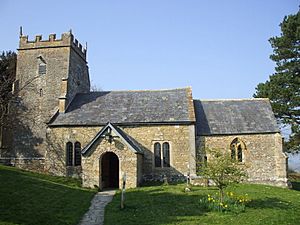Church of St Nicholas, Bratton Seymour facts for kids
Quick facts for kids Church of St Nicholas |
|
|---|---|
 |
|
| Location | Bratton Seymour, Somerset, England |
| Built | 13th century |
|
Listed Building – Grade II*
|
|
| Official name: Church of St Nicholas | |
| Designated | 24 March 1961 |
| Reference no. | 1177220 |
| Lua error in Module:Location_map at line 420: attempt to index field 'wikibase' (a nil value). | |
The Church of St Nicholas is an old and important church located in Bratton Seymour, a village in Somerset, England. It was built a very long time ago, in the 13th century. This church is recognized as a Grade II* listed building, which means it's a special historical place that needs to be protected.
A Look at the Church's Past
The Church of St Nicholas was first built in the 1200s. When it was first built, it was known by a different name, dedicated to St. Giles. It has also been called Holy Trinity Church at other times in its history.
Over the years, some parts of the church's stone walls and ceilings have become worn. Because of this, the building has been placed on the Heritage at Risk Register. This list helps make sure that important historical buildings get the care they need to stay strong.
The church is part of a group of local churches called the Camelot Parishes. These parishes belong to the Diocese of Bath and Wells, which is a larger church area.
Exploring the Church's Design
The Church of St Nicholas is made from strong stone. It uses special types of stone called Doulting and hamstone for its decorative parts. The roofs are covered with slate.
The church building has a main area called a nave with three sections, and a smaller area near the altar called a chancel with two sections. There's also a small room called a vestry and a porch on the south side.
Some of the walls in the nave still have pieces of carvings from the 12th century. This shows how old and unique the church truly is! The tall tower at the west end of the church has strong supports called buttresses. Inside the tower, there are bells that date back to the 14th and 15th centuries.
Most of the furniture and decorations inside the church were added in the 1800s. However, there is one very old and special item: a round Norman font. This font was used for baptisms and is from the Norman period, which was even earlier than when the church was first built.

